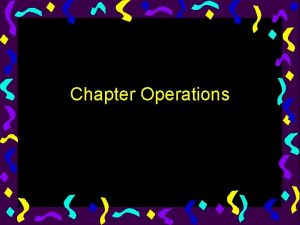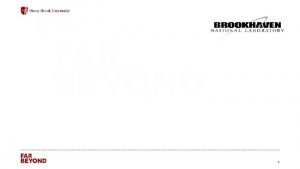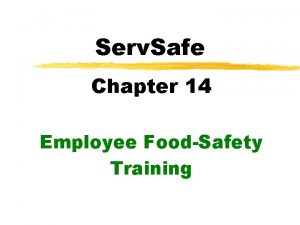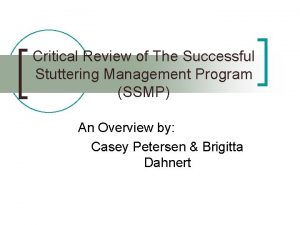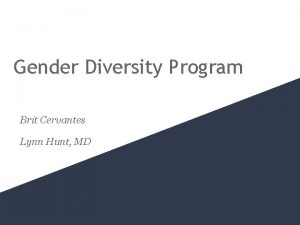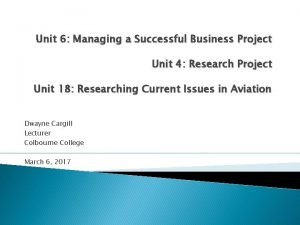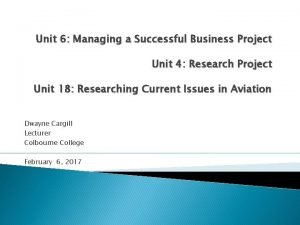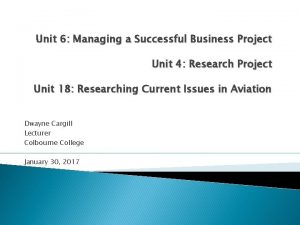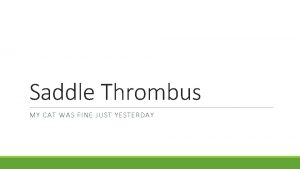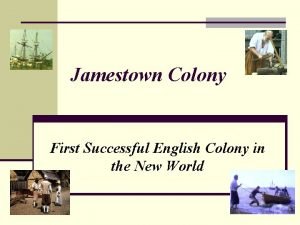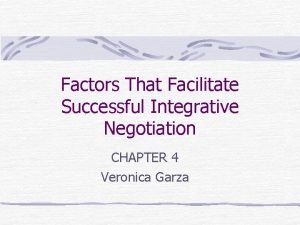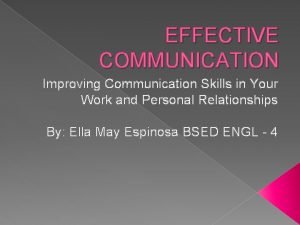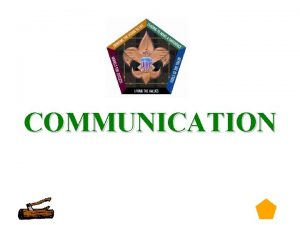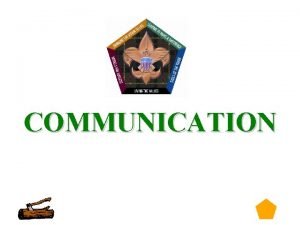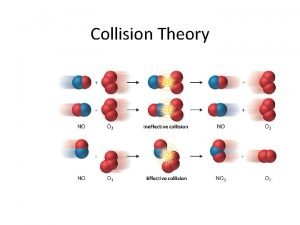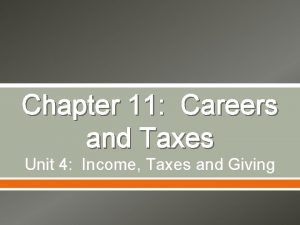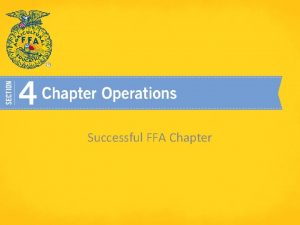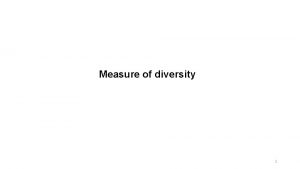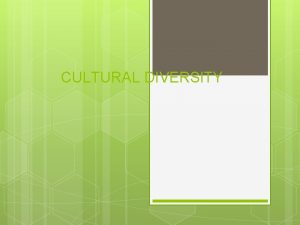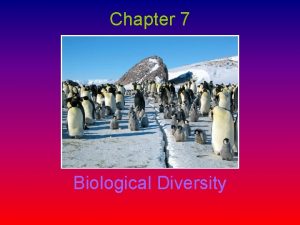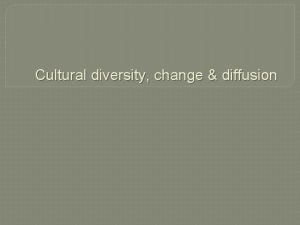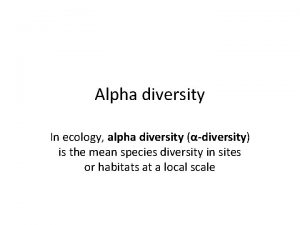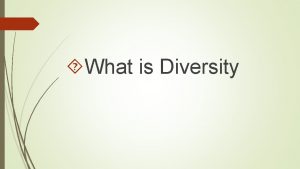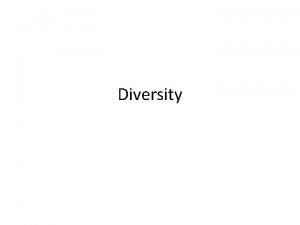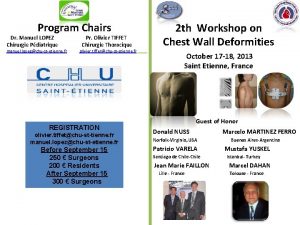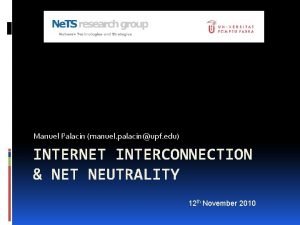Essentials of A Successful Diversity Program Le Manuel



















- Slides: 19

‘ Essentials of A Successful Diversity Program Le. Manuel Lee Bitsoi, Ed. D. Chief Diversity Officer - Stony Brook University Diversity Committee Member - Brookhaven National Laboratory 1

Diversity: The Final Frontier ‘ “Space, the final frontier…” • Space exploration is infinite Physics is the study of matter, energy and space • Constant discoveries Diversity is not a person, program or destination • An evolving interdependent ecosystem 2

Understanding Diversity • Indigenous epistemologies • Inclusive • Multidimensional • Intersectionality ‘ 3

Beyond Biological Constructs • Race/Ethnicity • Gender • Age • Sexual Orientation • Ability • Religion • National Origin • Language • Socio-economic Status • Veteran/Military ‘ • Political Ideology Source: National Association of Diversity Officers in Higher Education (NADOHE) 4

Diversity Approaches • Triage • Symbolic ‘ • Institutionalized 5 5

Components of Effective Diversity Programs • Intentionality (determine and understand need for diversity) • Dedicated resources • Diversity Leadership Council ‘ • Diversity Plan • Working Groups (invite champions) • Steering Committee (invite faculty, staff and students) • Implementation Plan (consult WGs and SC to determine the owners and drivers of tasks) 6 6

Action Items • Conduct Employee Climate Survey: Employee climate surveys help capture the perceived benefits of programs that many qualitative metrics miss. • Implementation from both strategic and tactic levels: • At strategic level: (1) Establish business-aligned diversity plans/goals, and systematically launch diversity programs/activities. (2) Integrate diversity into performance review, enhance commitment and ‘ involvement at all levels of management. • At tactic level: (1) Choose clear measurement forms to track diversity programs and activities. (2) Provide managers with coaching, education, and tools to help reach the goals. (3) Constantly review measurements and change them over time to ensure close alignment with business strategies and goals. • Source: What Diversity Metrics are Best Used to Track and Improve Employee Diversity? Balter, Chow & Jin (2014) 7 7

SBU Overarching Goals I. Improve the diversity of the Stony Brook Community through enhanced recruitment and retention. II. Expand educational, research, healthcare and other efforts to ensure that Stony Brook students have the ability to thrive as members of the campus community and as global citizens in a diverse society. ‘ III. Support the development of a campus climate that values diversity, equity and inclusion in a way that promotes the ability of members of the community to thrive and to achieve their individual goals. IV. Establish a culture of accountability and assessment around diversity and inclusion initiatives and policies. 8 8


Change Agents of Effective Diversity Programs • Steering Committee • Advisory Council • Working Groups • Diversity Leadership Council ‘ • Community Members • Evaluation Team • Metrics: Demographic Parity Index • Accountability: What was accomplished? How? Why not? • Showcase accomplishments 10 10

Diversity, Equity and Inclusion • Inextricably linked • An evolving interdependent ecosystem • Not a person, program or destination • Thermostat vs. thermometer • Collaborative partnerships ‘ 11

Brookhaven National Laboratory • Inclusion & Diversity Office • Brookhaven’s multi-year Inclusion & Diversity Strategy has four primary pillars that focus on (1) enhancing leadership awareness of implicit bias; (2) expanding/developing talent pipeline/pathways; (3) fostering retention of women and underrepresented minorities; and (4) engaging lab staff through ‘ employee resource and affinity groups. • Annual DOE Inclusion & Diversity Plan submitted on 04/16/18 • Inclusion & Diversity Leadership Council, the Management Steering Committee and Inclusion & Diversity Councils at the business unit levels • Shirley Kendall, Inclusion & Diversity Manager kendall@bnl. gov 12 12

CERN Membership ‘ • Over 600 institutes and universities around the world use CERN’s facilities. • Some 12, 000 visiting scientists from over 70 countries and with 105 different nationalities 13 13

Diverse Talents and Perspectives Hidden Figures – Female African American Scientists • In 1961, mathematician Katherine Goble works as a human computer in the gender segregated and racially segregated division West Area Computers of the Langley Research Center in Virginia, alongside her colleagues, aspiring engineer Mary Jackson and their unofficial acting-supervisor Dorothy Vaughan. • The day of the launch, discrepancies arise in the IBM 7090 calculations for the capsule's ‘ landing coordinates, and Astronaut Glenn requests that Katherine be called in to check them. She quickly does so, only to have the door slammed in her face after delivering the results to the control room. However, Harrison gives her a security pass so they can relay the results to Glenn together. • After a successful launch and orbit, the space capsule has a heat shield problem. Mission control decides to land it after three orbits instead of seven. Katherine suggests that they leave the retro-rocket attached to the heat shield for reentry. The instructions prove correct, and Friendship 7 successfully lands. 14

Diverse Talents and Perspectives A Beautiful Mind: John Nash, Ph. D. • In 1947, John Nash arrives at Princeton University as a co-recipient of the prestigious Carnegie Scholarship for mathematics. Nash is under extreme pressure to publish, but he wants to publish his own original idea. Nash develops a new concept of governing dynamics and publishes an article on this and is offered an appointment at MIT. • Nash is diagnosed with paranoid schizophrenia and hospitalized where he is given a ‘ course of insulin shock therapy and eventually released. Frustrated with the side effects of the antipsychotic medication he is taking, which make him lethargic and unresponsive, he secretly stops taking it. • Nash returns to Princeton and approaches his old rival, Hansen, now head of the mathematics department. He grants Nash permission to work out of the library and to audit classes. Over the next two decades, Nash learns to ignore his hallucinations. By the late 1970 s, he is allowed to teach again. • In 1994, Nash wins the Nobel Memorial Prize in Economics for his revolutionary work on game theory, and is honored by his fellow professors. 15

We need diversity! • “The pain associated with diversity can be thought of as the pain of exercise. You have to push yourself to grow your muscles. The pain, as the old saw goes, produces the gain. In just the same way, we need ‘ diversity—in teams, organizations and society as a whole—if we are to change, grow and innovate. ” • Source: Katherine W. Phillips, How Diversity Makes Us Smarter, Scientific American, October 2014 16

Moving Beyond Being PC • Unconscious Bias • Stereotyping • Microaggressions • Privilege • Giving Voice ‘ 17


Talent Pools & Resources Women in Science and Engineering (WISE) ‘ 19 19
 10 essentials of a successful ffa chapter
10 essentials of a successful ffa chapter What are the ten essentials of a successful ffa chapter
What are the ten essentials of a successful ffa chapter Genetic diversity vs species diversity
Genetic diversity vs species diversity Ecosystem jigsaw activity
Ecosystem jigsaw activity What are job aids servsafe
What are job aids servsafe Successful stuttering management program
Successful stuttering management program Uci gender diversity
Uci gender diversity Unit 6 managing a successful business project
Unit 6 managing a successful business project Unit 6: managing a successful business project pdf
Unit 6: managing a successful business project pdf Unit 6 managing a successful business project
Unit 6 managing a successful business project Secrets to successful strategy execution
Secrets to successful strategy execution Saddle thrombus cat
Saddle thrombus cat Rocky mountains geography map
Rocky mountains geography map Factors that facilitate successful integrative negotiation
Factors that facilitate successful integrative negotiation What makes communication successful
What makes communication successful What makes communication successful
What makes communication successful What makes communication successful
What makes communication successful Collision theory easy definition
Collision theory easy definition In the circles for a successful value proposition framework
In the circles for a successful value proposition framework Section 4 best practices of successful people
Section 4 best practices of successful people
